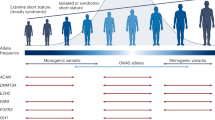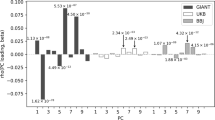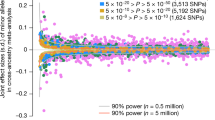Abstract
Recent success of genome-wide association studies (GWASs) on human height variation emphasized the effects of individual loci or genes. In this study, we used a developed pathway-based approach to further test biological pathways for potential association with stature, by examining ∼370 000 single-nucleotide polymorphisms (SNPs) across the human genome in 618 unrelated elder Han Chinese. A total of 626 biological pathways annotated by any of the three major public pathway databases (KEGG, BioCarta and Ambion GeneAssist Pathway Atlas) were tested. The regulation-of-autophagy (ROA) (nominal P=0.012) pathway was marginally significantly associated with human stature after our family wise error rate multiple-testing correction. We also used 1000 random recruited US whites for further replication. Interestingly, the ROA pathway presented the strongest signals in whites for height variation (nominal P=0.002). The results correspond to biological roles of the ROA pathway in human long bone development and growth. Our findings also implied that multiple-genetic factors may work jointly as a functional unit (pathway), and the traditional GWASs could have missed important genetic information imbedded in those less significant markers.
Similar content being viewed by others
Log in or create a free account to read this content
Gain free access to this article, as well as selected content from this journal and more on nature.com
or
References
Weedon, M. N. & Frayling, T. M. Reaching new heights: insights into the genetics of human stature. Trends Genet. 24, 595–603 (2008).
Li, M. X., Liu, P. Y., Li, Y. M., Qin, Y. J., Liu, Y. Z. & Deng, H. W. A major gene model of adult height is suggested in Chinese. J. Hum. Genet. 49, 148–153 (2004).
Molho-Pessach, V., Lerer, I., Abeliovich, D., Agha, Z., Abu Libdeh, A., Broshtilova, V. et al. The H syndrome is caused by mutations in the nucleoside transporter hENT3. Am. J. Hum. Genet. 83, 529–534 (2008).
Ofluoglu, D., Unlu, F. & Akyuz, G. Relationship between arm span and height in postmenopausal osteoporotic women. Rheumatol. Int. 28, 737–741 (2008).
Lei, S. F., Tan, L. J., Liu, X. G., Wang, L., Yan, H., Guo, Y. F. et al. Genome-wide association study identifies two novel loci containing FLNB and SBF2 genes underlying stature variation. Hum. Mol. Genet. 18, 1661–1669 (2009).
Lettre, G., Jackson, A. U., Gieger, C., Schumacher, F. R., Berndt, S. I., Sanna, S. et al. Identification of ten loci associated with height highlights new biological pathways in human growth. Nat. Genet. 40, 584–591 (2008).
Johansson, A., Marroni, F., Hayward, C., Franklin, C. S., Kirichenko, A. V., Jonasson, I. et al. Common variants in the JAZF1 gene associated with height identified by linkage and genome-wide association analysis. Hum. Mol. Genet. 18, 373–380 (2009).
Weedon, M. N., Lettre, G., Freathy, R. M., Lindgren, C. M., Voight, B. F., Perry, J. R. et al. A common variant of HMGA2 is associated with adult and childhood height in the general population. Nat. Genet. 39, 1245–1250 (2007).
Weedon, M. N., Lango, H., Lindgren, C. M., Wallace, C., Evans, D. M., Mangino, M. et al. Genome-wide association analysis identifies 20 loci that influence adult height. Nat. Genet. 40, 575–583 (2008).
Gudbjartsson, D. F., Walters, G. B., Thorleifsson, G., Stefansson, H., Halldorsson, B. V., Zusmanovich, P. et al. Many sequence variants affecting diversity of adult human height. Nat. Genet. 40, 609–615 (2008).
Krane, S. M. & Inada, M. Matrix metalloproteinases and bone. Bone 43, 7–18 (2008).
Estrada, K., Krawczak, M., Schreiber, S., van Duijn, K., Stolk, L., van Meurs, J. B. et al. A genome-wide association study of northwestern Europeans involves the C-type natriuretic peptide signaling pathway in the etiology of human height variation. Hum. Mol. Genet. 18, 3516–3524 (2009).
Lei, S. F., Yang, T. L., Tan, L. J., Chen, X. D., Guo, Y., Guo, Y. F. et al. Genome-wide association scan for stature in Chinese: evidence for ethnic specific loci. Hum. Genet. 125, 1–9 (2009).
Wang, K., Li, M. & Bucan, M. Pathway-based approaches for analysis of genomewide association studies. Am. J. Hum. Genet. 81, 1278–1283 (2007).
Pritchard, J. K., Stephens, M. & Donnelly, P. Inference of population structure using multilocus genotype data. Genetics 155, 945–959 (2000).
Price, A. L., Patterson, N. J., Plenge, R. M., Weinblatt, M. E., Shadick, N. A. & Reich, D. Principal components analysis corrects for stratification in genome-wide association studies. Nat. Genet. 38, 904–909 (2006).
Purcell, S., Neale, B., Todd-Brown, K., Thomas, L., Ferreira, M. A., Bender, D. et al. PLINK: a tool set for whole-genome association and population-based linkage analyses. Am. J. Hum. Genet. 81, 559–575 (2007).
Zheng, G., Freidlin, B., Li, Z. & Gastwirth, J. L. Genomic control for association studies under various genetic models. Biometrics 61, 186–192 (2005).
Srinivas, V. & Shapiro, I. M. Chondrocytes embedded in the epiphyseal growth plates of long bones undergo autophagy prior to the induction of osteogenesis. Autophagy 2, 215–216 (2006).
Srinivas, V., Bohensky, J., Zahm, A. M. & Shapiro, I. M. Autophagy in mineralizing tissues: microenvironmental perspectives. Cell Cycle 8, 391–393 (2009).
Srinivas, V., Bohensky, J. & Shapiro, I. M. Autophagy: a new phase in the maturation of growth plate chondrocytes is regulated by HIF, mTOR and AMP kinase. Cells Tissues Organs 189, 88–92 (2009).
Roach, H. I., Aigner, T. & Kouri, J. B. Chondroptosis: a variant of apoptotic cell death in chondrocytes? Apoptosis 9, 265–277 (2004).
Lum, J. J., Bauer, D. E., Kong, M., Harris, M. H., Li, C., Lindsten, T. et al. Growth factor regulation of autophagy and cell survival in the absence of apoptosis. Cell 120, 237–248 (2005).
Avnet, S., Cenni, E., Perut, F., Granchi, D., Brandi, M. L., Giunti, A. et al. Interferon-alpha inhibits in vitro osteoclast differentiation and renal cell carcinoma-induced angiogenesis. Int. J. Oncol. 30, 469–476 (2007).
Oreffo, R. O., Romberg, S., Virdi, A. S., Joyner, C. J., Berven, S. & Triffitt, J. T. Effects of interferon alpha on human osteoprogenitor cell growth and differentiation in vitro. J. Cell Biochem. 74, 372–385 (1999).
Herold, C., Steffens, M., Brockschmidt, F. F., Baur, M. P. & Becker, T. INTERSNP: genome-wide interaction analysis guided by a priori information. Bioinformatics 25, 3275–3281 (2009).
O’Dushlaine, C., Kenny, E., Heron, E. A., Segurado, R., Gill, M., Morris, D. W. et al. The SNP ratio test: pathway analysis of genome-wide association datasets. Bioinformatics 25, 2762–2763 (2009).
Miller, D. J., Zhang, Y., Yu, G., Liu, Y., Chen, L., Langefeld, C. D. et al. An algorithm for learning maximum entropy probability models of disease risk that efficiently searches and sparingly encodes multilocus genomic interactions. Bioinformatics 25, 2478–2485 (2009).
Torkamani, A. & Schork, N. J. Pathway and network analysis with high-density allelic association data. Methods Mol. Biol. 563, 289–301 (2009).
Peng, G., Luo, L., Siu, H., Zhu, Y., Hu, P., Hong, S. et al. Gene and pathway-based second-wave analysis of genome-wide association studies. Eur. J. Hum. Genet. 18, 111–117 (2010).
Chen, Y., Xiong, D. H., Guo, Y. F., Pan, F., Zhou, Q., Zhang, F. et al. Pathway-based genome-wide association analysis identified the importance of EphrinA-EphR pathway for femoral neck bone geometry. Bone 46, 129–136 (2010).
Wang, K., Zhang, H., Kugathasan, S., Annese, V., Bradfield, J. P., Russell, R. K. et al. Diverse genome-wide association studies associate the IL12/IL23 pathway with Crohn Disease. Am. J. Hum. Genet. 84, 399–405 (2009).
Lesnick, T. G., Papapetropoulos, S., Mash, D. C., Ffrench-Mullen, J., Shehadeh, L., de Andrade, M. et al. A genomic pathway approach to a complex disease: axon guidance and Parkinson disease. PLoS Genet. 3, e98 (2007).
Lesnick, T. G., Sorenson, E. J., Ahlskog, J. E., Henley, J. R., Shehadeh, L., Papapetropoulos, S. et al. Beyond Parkinson disease: amyotrophic lateral sclerosis and the axon guidance pathway. PLoS One 3, e1449 (2008).
Guo, Y. F., Li, J., Chen, Y., Zhang, L. S. & Deng, H. W. A new permutation strategy of pathway-based approach for genome-wide association study. BMC Bioinformatics 10, 429 (2009).
Acknowledgements
We thank two anonymous reviewers for their time and effort in helping us improve and clarify this manuscript. HWD was partially supported by grants from NIH (P50AR055081, R01AG026564, R01AR050496, RC2DE020756, R01AR057049 and R03TW008221) and Franklin D Dickson/Missouri Endowment. The study also benefited from grants from National Science Foundation of China, Huo Ying Dong Education Foundation, HuNan Province, Xi’an Jiaotong University and the Ministry of Education of China. This study was supported by NIH grants from R01 AR050496, R21 AG027110, R01 AG026564, P50 AR055081 and R21 AA015973.
Author information
Authors and Affiliations
Corresponding author
Ethics declarations
Competing interests
The authors declare no conflict of interest.
Rights and permissions
About this article
Cite this article
Pan, F., Liu, XG., Guo, YF. et al. The regulation-of-autophagy pathway may influence Chinese stature variation: evidence from elder adults. J Hum Genet 55, 441–447 (2010). https://doi.org/10.1038/jhg.2010.44
Received:
Revised:
Accepted:
Published:
Issue date:
DOI: https://doi.org/10.1038/jhg.2010.44
Keywords
This article is cited by
-
Autophagy in bone homeostasis and the onset of osteoporosis
Bone Research (2019)
-
Autophagy Regulates Craniofacial Bone Acquisition
Calcified Tissue International (2019)
-
Autophagy as a target for glucocorticoid-induced osteoporosis therapy
Cellular and Molecular Life Sciences (2018)
-
Pathway-Based Genome-Wide Association Studies for Two Meat Production Traits in Simmental Cattle
Scientific Reports (2015)
-
Autophagy—a key player in cellular and body metabolism
Nature Reviews Endocrinology (2014)



